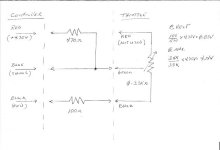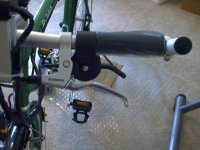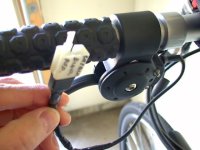Russell
1 MW
the TRIGGER throttle.
To me a full twist throttle is at home on a motorcycle where the rider is stationary and usually in an upright or even laid back position but they don't seem to be the best solution on an ebike which someone is actually pedaling and may even be getting out of the saddle from time to time. The full twist throttle that came with my kit is hard plastic and I know it would be a real pain holding it in position for any length of time. I ordered a left hand thumb throttle but then I noticed many active vehicles where the rider may be getting jostled such as ATV's and jet skis often have trigger throttles. Of course those are cable actuated but I did find a trigger throttle used on an electric scooter to try.
The trigger throttle I puchased is advertised as a "5K" model so I knew it might not work perfectly since my stock throttle is a hall effect model. I measured the voltages of the stock throttle at rest and at full throttle as well as the supply voltage, they were: 0.83V, 4.07V and 4.75V, respectively. When the new trigger throttle arrived I found it actually used a 10K potentiometer so it didn't work properly out of the box.
Here's what I did to make it work;
First I opened it up and adjusted the pot (small gear) so that the resistance between the green wire (signal) and the black wire (GND) varied between 0 and 3.3K ohms by rotating the gear a bit and reinstalling the cover. Stock it ranged between 1K and 4.5K and the red wire to green wire (edit: corrected from "red wire to black wire") varied from 9K to 5.5K.
View attachment 2
Next I added a 470 ohm and 100 ohm resistor as shown below:
UPDATE May 5, 2009: the motor reached full power before the throttle was at the end of its travel, which is ok but I wanted to use the full sweep of the throttle to get finer control over the speed when I swapped out a Bafang motor for a more powerful 9C model. To do this I changed the 100 ohm resistor to 220 ohm and the 470 ohm to 1K-ohm. This change resulted in response a bit sooner when the throttle was first pulled and more progressive action throughout the arc of the lever. One problem however was that my thick grips prevented the lever from reaching its full travel so I had to swap the grips for thinner ones, but it is close even with them.

It works quite well now with instant response as soon as I pull the lever. Here it is mounted on my bike:

The throttle is angled just forward of vertical. It's nice since now I can just grab the lever and hold on pretty much like I usually do when riding a non-powered bike. The downside is the throttle is larger than I expected so I'm going to use a downtube shifter to control the front derailleur. Since many folks don't use their lower gears once they motorize their bikes they could just as well eliminate the front shifter and derailleur.
I purchased the throttle here;
http://www.extremescooters.biz/throttleleverbladezpart70171.aspx (EDIT: no longer available)
10/21/2009 Try here? http://www.justformotorsports.com/p...ADEZ-Lever-Throttle-Assy-For-Electric-Scooter
-R
To me a full twist throttle is at home on a motorcycle where the rider is stationary and usually in an upright or even laid back position but they don't seem to be the best solution on an ebike which someone is actually pedaling and may even be getting out of the saddle from time to time. The full twist throttle that came with my kit is hard plastic and I know it would be a real pain holding it in position for any length of time. I ordered a left hand thumb throttle but then I noticed many active vehicles where the rider may be getting jostled such as ATV's and jet skis often have trigger throttles. Of course those are cable actuated but I did find a trigger throttle used on an electric scooter to try.
The trigger throttle I puchased is advertised as a "5K" model so I knew it might not work perfectly since my stock throttle is a hall effect model. I measured the voltages of the stock throttle at rest and at full throttle as well as the supply voltage, they were: 0.83V, 4.07V and 4.75V, respectively. When the new trigger throttle arrived I found it actually used a 10K potentiometer so it didn't work properly out of the box.
Here's what I did to make it work;
First I opened it up and adjusted the pot (small gear) so that the resistance between the green wire (signal) and the black wire (GND) varied between 0 and 3.3K ohms by rotating the gear a bit and reinstalling the cover. Stock it ranged between 1K and 4.5K and the red wire to green wire (edit: corrected from "red wire to black wire") varied from 9K to 5.5K.
View attachment 2
Next I added a 470 ohm and 100 ohm resistor as shown below:
UPDATE May 5, 2009: the motor reached full power before the throttle was at the end of its travel, which is ok but I wanted to use the full sweep of the throttle to get finer control over the speed when I swapped out a Bafang motor for a more powerful 9C model. To do this I changed the 100 ohm resistor to 220 ohm and the 470 ohm to 1K-ohm. This change resulted in response a bit sooner when the throttle was first pulled and more progressive action throughout the arc of the lever. One problem however was that my thick grips prevented the lever from reaching its full travel so I had to swap the grips for thinner ones, but it is close even with them.

It works quite well now with instant response as soon as I pull the lever. Here it is mounted on my bike:

The throttle is angled just forward of vertical. It's nice since now I can just grab the lever and hold on pretty much like I usually do when riding a non-powered bike. The downside is the throttle is larger than I expected so I'm going to use a downtube shifter to control the front derailleur. Since many folks don't use their lower gears once they motorize their bikes they could just as well eliminate the front shifter and derailleur.
I purchased the throttle here;
http://www.extremescooters.biz/throttleleverbladezpart70171.aspx (EDIT: no longer available)
10/21/2009 Try here? http://www.justformotorsports.com/p...ADEZ-Lever-Throttle-Assy-For-Electric-Scooter
-R


